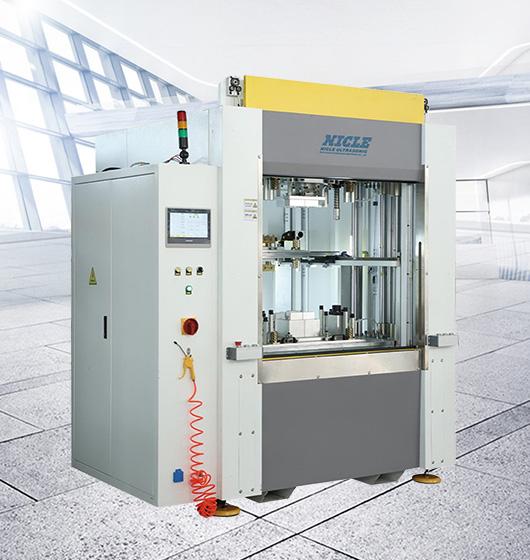Automation and Process Integration in Servo Hot Plate Welding Machines
Servo hot plate machines have become a key component in the revolution of automation and advanced technologies. These machines provide precision and efficiency, and when integrated into fully automated production lines, they bring numerous benefits.
However, to fully realize their potential, it’s essential to explore the challenges and advantages of integrating these machines, with a particular focus on servo hot plate welding machines, real-time monitoring, and seamless data collection for quality assurance.
In this article, we will examine how servo hot plate welders can be effectively integrated into automated lines, discussing the challenges and benefits of process integration, quality control, and automation.
1. What is a Servo Hot Plate Machine?
A servo hot plate machine is a sophisticated device used for welding plastic parts using a heated plate. The machine utilizes a servo-driven hot plate welding machine, which employs high-precision servo motors to control the movement of the welding plate, offering better accuracy and flexibility compared to traditional hydraulic or pneumatic systems.
The servo hot plate welding process involves the melting of the plastic components between two plates: one stationary and one heated. The heat causes the plastic to soften and fuse, creating a strong bond between the parts. The servo hot plate welder ensures that the temperature, pressure, and time are precisely controlled, resulting in consistent, high-quality welds.
You can have a broader view of plastic welding machines and the role they play in modern manufacturing to look at various welding solutions available for different applications.
2. The Case for Automation in Manufacturing
a) Increased Productivity and Efficiency
One of the key reasons for integrating servo hot plate machines into manufacturing lines is to increase productivity and efficiency.
When a servo hot plate welding machine is incorporated into an automated system, it can operate continuously without the need for breaks or shift changes. This increases output, reduces the cycle time per weld, and enhances overall operational efficiency.
Automation also eliminates human error, which can occur in manual operations, ensuring consistent results with each weld. For example, a servo-driven hot plate welding machine can perform precise, identical welds across hundreds or thousands of components without variation, something that would be challenging for human operators to replicate.
b) Enhanced Precision and Quality Control
The integration of servo hot plate welders into an automated production line allows for greater precision in the welding process.
Unlike traditional systems, which may have less control over parameters like temperature and pressure, the servo-driven hot plate welding machine offers fine-tuned control. This precision ensures that the welds meet the required specifications and quality standards consistently.
In addition, the automation of servo hot plate welding machines allows for continuous monitoring of key parameters. With real-time data collection, manufacturers can detect and address any issues during the welding process, before they affect the final product.
c) Streamlined Operations and Flexibility
Integrating a servo hot plate machine into a fully automated line streamlines operations and reduces the need for manual intervention. These machines can easily be programmed to handle a variety of part types and sizes, offering exceptional flexibility in production.
For example, a servo hot plate welding machine can seamlessly switch between different products without the need for extensive retooling or setup changes, making it ideal for manufacturers that need to quickly adapt to changing production demands.
Automation also eliminates the need for operators to monitor every step of the process. Once the system is set up, it can run with minimal supervision, freeing up resources and improving overall productivity.
3. Challenges of Integrating Servo Hot Plate Machines into Automated Lines
a) High Initial Investment
While the integration of servo hot plate welding machines into an automated production line offers long-term benefits, the initial investment can be a significant hurdle.
The cost of a servo-driven hot plate welding machine, including the necessary control systems, sensors, and automation equipment, can be considerable. For small to medium-sized manufacturers, this upfront cost may be prohibitive.
However, despite the high initial cost, the return on investment (ROI) can be significant. The increased efficiency, reduced waste, and higher throughput can ultimately offset the initial expenditure. Moreover, many manufacturers find that automated systems pay for themselves over time through reduced labor costs and enhanced product quality.
b) Compatibility with Existing Systems
Integrating a servo hot plate machine into an existing production line can be challenging, especially when dealing with older equipment.
Existing machinery may not be compatible with modern automation systems, requiring significant modifications or even complete replacements. Even newer equipment may require software updates or additional hardware to ensure that all systems communicate effectively.
Servo hot plate welding machine can integrate with existing manufacturing processes, control systems, and network infrastructures. This may require hiring specialists to manage the integration and ensure a smooth transition.
c) Skilled Labor and Training
The successful integration of a servo hot plate welding machine into an automated system requires skilled operators and maintenance personnel. These machines, while relatively user-friendly, are complex and require in-depth knowledge to operate and troubleshoot effectively.
The need for highly skilled labor to monitor, manage, and maintain these systems is a critical consideration for manufacturers. Additionally, staff must be trained in predictive maintenance and troubleshooting to minimize downtime and avoid costly repairs.
4. Real-Time Monitoring and Data Collection for Quality Assurance
a) Continuous Process Monitoring
One of the significant advantages of integrating servo-driven hot plate welding machines into an automated line is the ability to implement continuous process monitoring.
This is achieved using sensors, cameras, and control software that track each phase of the welding process in real-time. Key parameters like temperature, pressure, and weld time can be monitored throughout the production cycle.
For example, a servo hot plate welding machine can incorporate temperature sensors that ensure the plate reaches the optimal welding temperature. Likewise, pressure sensors can verify that the right amount of force is applied to the parts, which helps to maintain the integrity of the weld.
Continuous monitoring allows manufacturers to detect anomalies early, preventing defective products from leaving the production line.
b) Predictive Maintenance and Reduced Downtime
Another major benefit of real-time monitoring is predictive maintenance. A servo hot plate machine that is integrated into an automated line can be equipped with sensors that track machine health. By monitoring variables such as motor load, temperature, and vibrations, predictive algorithms can analyze the data and predict potential failures before they occur.
This helps reduce unplanned downtime by allowing maintenance teams to perform repairs during scheduled breaks or downtime periods. Predictive maintenance extends the lifespan of the servo hot plate welding machine and ensures that production schedules are maintained without unexpected interruptions.
c) Seamless Data Collection for Quality Assurance
Automating the data collection process is a typical feature of modern manufacturing systems. By integrating a servo hot plate welding machine with real-time monitoring tools, manufacturers can collect a comprehensive set of data for each welding cycle. This data can include temperature readings, cycle times, force applied, and any deviations from normal operating parameters.
This information can be automatically recorded, providing a detailed traceability record for quality assurance purposes. It also enables manufacturers to analyze trends over time, pinpoint areas for process improvement, and track the performance of individual machines.
For industries with strict regulatory requirements, such as automotive or medical manufacturing, having this level of data is important for compliance and ensuring product integrity.
5. Benefits of Process Integration
a) Greater Flexibility and Adaptability
Integrating servo hot plate welding machines into fully automated lines allows manufacturers to easily adapt to changes in production.
Automated systems can be reprogrammed quickly to accommodate different part designs, materials, and production volumes. This flexibility is a significant advantage for industries that require frequent changes to production schedules and product specifications.
b) Enhanced Decision-Making through Data
The seamless collection of data from servo-driven hot plate welding machines enables manufacturers to make more informed decisions. Data analytics can highlight areas of inefficiency, product defects, or process bottlenecks, allowing manufacturers to address problems proactively.
For instance, if a certain parameter consistently deviates from the set standard, the system can alert operators, enabling them to adjust the machine settings before defects occur.
c) Improved Product Quality and Consistency
Automation ensures that each weld produced by a servo hot plate welding machine is identical, reducing human error and improving consistency. This leads to higher quality products and lower scrap rates, which ultimately translates into reduced waste and cost savings.
Manufacturers can rely on servo hot plate welders to deliver the same level of precision with every cycle, ensuring that products meet strict quality standards.
6. Conclusion
The integration of servo hot plate welding machines into fully automated manufacturing lines offers significant benefits, including enhanced precision, increased productivity, and improved product quality.
By implementing continuous monitoring, predictive maintenance, and seamless data collection, manufacturers can optimize their processes, reduce downtime, and ensure the consistent delivery of high-quality products.





